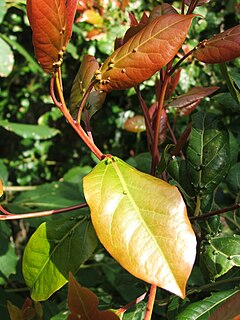
Ocotea is a genus of flowering plants belonging to the family Lauraceae. Many are evergreen trees with lauroid leaves.

Ocotea bullata, is a species of flowering tree native to South Africa. It produces very fine and valuable timber which was formerly much sought after to make furniture. Due to over-exploitation it is now a protected species. Other names for it are Cape Walnut, Cape laurel, and laurel wood. The name "stinkwood" comes from a strong smell that is released when it is fresh felled.

Pinus oocarpa is a species of pine tree native to Mexico and Central America. It is the national tree of Honduras, where it is known as ocote. Common names include ocote chino, pino amarillo, pino avellano, Mexican yellow pine, egg-cone pine and hazelnut pine. It appears that it was the progenitor (original) species that served as the ancestor for some of the other pines of Mexico.
Ocotea argylei is a species of Ocotea in the plant family Lauraceae. It is a medium-sized to large tree 10–21 m tall, in some case to 30 m. Its status is classed as vulnerable. It is endemic to Kenya. The fruits are oblong berries which are covered by a cup-shaped cupule where they join the peduncle, giving them an appearance similar to an acorn. The leaves are elliptic with an acuminate tip. O. argylei is classified in the Flora of Tropical East Africa by the Royal Botanic Gardens, of Kew as Ocotea kenyensis (Chiov.) Robyns & R. Wilczek, with which it is possibly synonymous.
Ocotea cymbarum is a species of Ocotea in the plant family Lauraceae. It is an evergreen tree found in Brazil, Colombia, French Guiana, Guyana, Suriname, and Venezuela.

Ocotea foetens, commonly called til or stinkwood is a species of tree in the family Lauraceae. It is evergreen and grows up to 40 m tall. It is a common constituent of the laurisilva forests of Madeira and the Canary Islands. Leaf fossils of this species are known from the Mio-Pleistocene of Madeira Island.
Ocotea kenyensis is a species of plant in the family Lauraceae. It is found in the Democratic Republic of the Congo, Ethiopia, Kenya, Malawi, Mozambique, Rwanda, South Africa, Sudan, Swaziland, Tanzania, Uganda, and Zimbabwe. It is threatened by habitat loss.

Ocotea porosa is a species of plant in the Lauraceae, often placed in the related genus Phoebe. It is commonly called imbuia or Brazilian walnut because its wood resembles that of some walnuts. The tree is a major commercial timber species in Brazil, used for high-end furniture, mostly as decorative veneers, and as flooring. The wood is very hard, measuring 3,684 lbf on the Janka scale. The wood is also fragrant with hints of nutmeg and cinnamon. The tree is also a popular horticultural tree in subtropical regions of the world. In its native habitat it is a threatened species.

Ocotea odorifera is a species of plant in the family Lauraceae. It is an evergreen tree in the genus Ocotea.
Ocotea puberula is a species of evergreen tree in the plant genus Ocotea of the family Lauraceae. It is found in Argentina, Brazil, French Guiana, Guyana, Mexico, Peru, and Suriname.
Ocotea rivularis is a species of evergreen tree in the plant genus Ocotea of the family Lauraceae. It is endemic to Costa Rica.
Ocotea rotundata is a species of evergreen tree in the genus of plants Ocotea, in the family Lauraceae. It is endemic to Ecuador. Its natural habitat is subtropical or tropical moist montane forests.
Ocotea staminoides is a species of evergreen tree in the plant genus Ocotea of the family Lauraceae. It is endemic to Jamaica.
Ocotea uxpanapana is a species of plant in the family Lauraceae. It is a species of evergreen tree in the genus Ocotea.

Adhemarius tigrina is a moth of the family Sphingidae.

Adhemarius eurysthenes is a species of moth in the family Sphingidae. It was described by Rudolf Felder in 1874, and is known from Brazil, Colombia and Paraguay.

Adhemarius roessleri is a species of moth in the family Sphingidae. It was described by Ulf Eitschberger in 2002, and is known from Brazil, Colombia, Guyana, northern Peru and French Guiana.

Adhemarius ypsilon is a species of moth in the family Sphingidae. It was described by Rothschild and Jordan in 1903 and is known from Costa Rica, Mexico, Belize, Guatemala, Nicaragua, Venezuela, French Guiana, Ecuador, Peru, and Bolivia.

Quercus oocarpa is a Mesoamerican species of oak. It is native to Central America and eastern Mexico, with an isolated population in canyons of Jalisco in western Mexico.
Corymbia oocarpa is a species of tree that is endemic to the Top End of the Northern Territory. It has thin rough bark on the lower part of the trunk, smooth bark above, lance-shaped to curved adult leaves, flower buds in groups of seven, white flowers and barrel-shaped to urn-shaped fruit.










